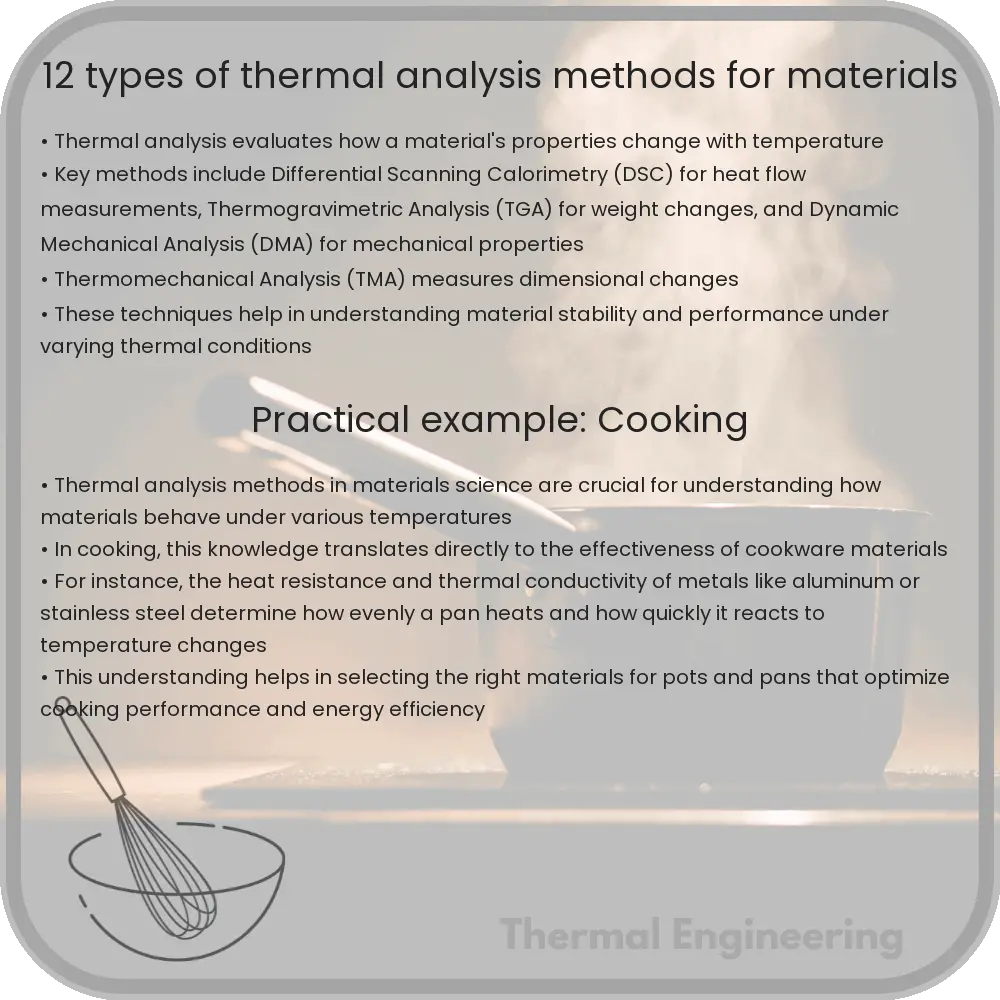Learn about the 12 types of thermal analysis methods used to study material properties as they change with temperature.

Introduction to Thermal Analysis Methods
Thermal analysis is a branch of materials science where the properties of materials are studied as they change with temperature. Various methods of thermal analysis measure different aspects such as phase transitions, oxidation, and thermal stability. This article explores 12 types of thermal analysis methods commonly used to characterize material properties.
1. Differential Scanning Calorimetry (DSC)
Differential Scanning Calorimetry (DSC) measures how much heat is required to increase the temperature of a sample compared to a reference. It is widely used to analyze melting, crystallization, and specific heat capacity.
2. Thermogravimetric Analysis (TGA)
Thermogravimetric Analysis (TGA) measures the change in mass of a sample as it is heated or cooled. It is useful for studying materials’ thermal stability, decomposition, and compositional changes.
3. Differential Thermal Analysis (DTA)
Differential Thermal Analysis (DTA) involves heating or cooling a sample and a reference under identical conditions and observing any temperature differences. This technique helps detect phase transitions, such as melting and crystallization.
4. Thermomechanical Analysis (TMA)
Thermomechanical Analysis (TMA) measures the dimensional changes in a material as a function of temperature. It is used to study thermal expansion, softening, and glass transition temperature.
5. Dynamic Mechanical Analysis (DMA)
Dynamic Mechanical Analysis (DMA) measures the mechanical properties of materials as they are deformed under periodic stress. It provides insights into viscoelastic behavior, glass transitions, and softening points.
6. Dielectric Thermal Analysis (DETA)
Dielectric Thermal Analysis (DETA) analyzes the dielectric properties (dielectric constant and loss factor) of a material as a function of temperature and frequency. This method is crucial for investigating the behavior of polymers.
7. Thermally Stimulated Current (TSC)
Thermally Stimulated Current (TSC) measures the flow of electric current when a thermally insulated material is heated after being electrically polarized. TSC is used for studying charge trapping and release in materials.
8. Laser Flash Analysis (LFA)
Laser Flash Analysis (LFA) measures thermal diffusivity and conductivity. A pulse of a laser is applied to one side of a sample, and the temperature change on the opposite side is recorded to evaluate thermal properties.
9. Hot Disk Method
The Hot Disk Method involves placing a sensor between two sections of the sample material and passing an electric current through the sensor to raise the temperature. This test determines thermal conductivity and diffusivity.
10. Isothermal Titration Calorimetry (ITC)
Isothermal Titration Calorimetry (ITC) measures the heat released or absorbed during a chemical reaction at constant temperature. It is particularly useful in the study of binding interactions and energetics in biochemical processes.
11. Thermal Conductivity Meter
A Thermal Conductivity Meter directly measures a material’s ability to conduct heat. This method involves applying a known amount of heat to one side of the sample and measuring the temperature response.
12. Microscale Thermophoresis (MST)
Microscale Thermophoresis (MST) tracks the movement of molecules in temperature gradients to study molecular interactions, especially useful in pharmaceutical and biochemical research.
Conclusion
Understanding these thermal analysis methods helps in the selection of suitable materials for specific applications, contributing to advancements in various industries including aerospace, electronics, construction, and pharmaceuticals. Each method provides a different set of data invaluable for scientific and engineering decisions.